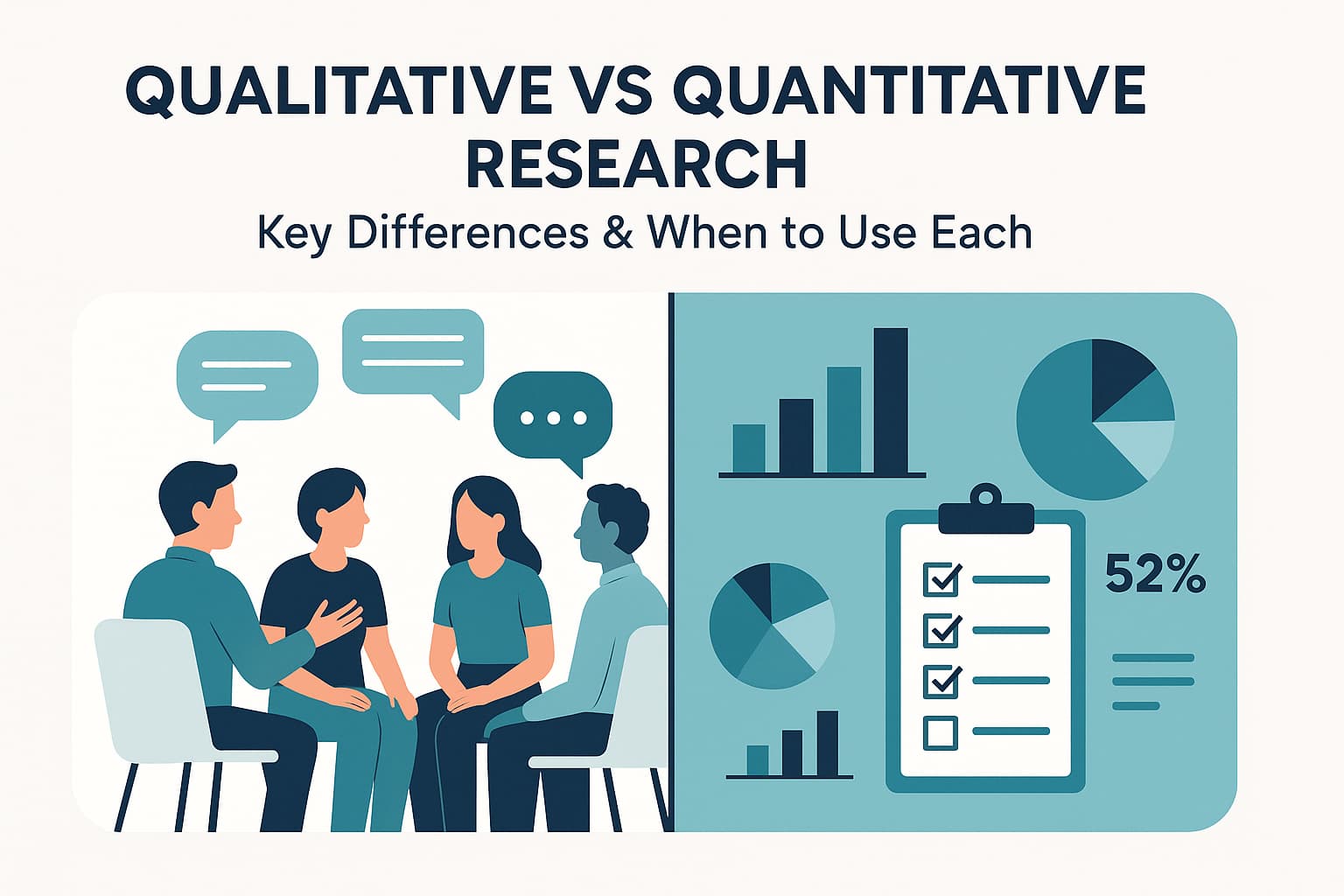Qualitative vs Quantitative Research: When we start any research, the first and most crucial question is whether to conduct qualitative or quantitative research. The method you use will have a significant impact on the success of your research. If the method is not selected correctly, the outcomes will likewise be incorrect. As a result, it is critical to make this decision with caution and in accordance with the circumstances.
In qualitative research, we try to comprehend people's experiences, views, feelings and thoughts. This strategy is useful when we need to learn a subject thoroughly. Quantitative research, on the other hand, uses statistics and data to infer patterns, trends, and conclusions. It is used for measuring and comparing data.
In this blog, we will discuss about the differences between qualitative and quantitative research when each method should be used, and why this is crucial to grasp.
Qualitative vs Quantitative Research
Now we’ll explain Qualitative and Quantitative Research in detail. Below, you’ll see how they are different, when to use them, and some simple examples.
What is Qualitative Research?
Qualitative Research is used to understand people’s thoughts, feelings and experiences. It’s not about numbers but about words and ideas. It helps you find out why people think or feel a certain way.
Some common methods are:
- Interviews
- Open-ended surveys
- Focus groups
Example: If you want to know how customers feel about your new product, you can talk to a few of them in detail. That’s Qualitative Research.
What is quantitative research?
Quantitative Research is about numbers and facts. It helps you measure things and compare results using data. It answers questions like how many, how much, or how often.
Some common methods are:
- Multiple-choice surveys
- Polls
- Experiments
- Statistics
Example: If you want to know how many people like Product A more than Product B, Quantitative Research is the way to go.
When to Use Qualitative Research
Qualitative research is best used when you want to gain a deep understanding of a topic. It focuses on exploring people's thoughts, feelings, experiences, and perceptions rather than relying solely on numbers. This type of research is especially useful when you’re trying to understand the “why” or “how” behind a situation.
Use qualitative research when:
- You want to explore a subject in depth.
- You need to understand opinions, emotions or personal experiences.
- You are in the early stages of a project and things are still unclear.
Common methods include interviews, focus groups, and observations. These helps uncover deeper insights that numbers alone can't reveal.
When to Use Quantitative Research
Quantitative research is helpful when you need clear, measurable data to support your findings. It focuses on numbers, patterns and statistical analysis, making it ideal for situations where facts, comparisons, and large-scale data collection are important.
Use quantitative research when:
- You need facts and numerical data.
- You want to compare different options or groups.
- You plan to collect information from a large number of people.
This type of research helps identify trends, measure behavior, and test hypotheses. Common methods include surveys, questionnaires, and experiments with closed-ended questions that can be counted and analyzed statistically.
Example: If you want to find out which brand is most popular among consumers. By surveying 1,000 people and asking them to choose their favorite brand from a list, you can collect measurable data. The results will show which brand ranks highest, how strong the preference is, and how different groups respond. This approach is best when you need reliable data to make comparisons or draw general conclusions from a larger population.
Can You Use Both? (Mixed Methods)
Sometimes, the best approach is to use both qualitative and quantitative research together. This is known as Mixed Methods. It allows you to gather solid numerical data while also understanding the deeper meaning behind it. By combining both approaches, you get a more complete and well-rounded picture.
Why use mixed methods?
Quantitative research tells you what is happening through numbers and statistics while qualitative research helps explain why it’s happening. Using both can strengthen your findings and make your conclusions more reliable. This approach helps you not only see the overall trend but also interpret the human side of the data. Mixed methods are especially useful in complex projects where both measurement and understanding are important.
How to Choose the Right One
Choosing between qualitative and quantitative research depends on your research goals, available resources and the kind of information you need. To make the right decision, start by asking yourself a few key questions:
- What is my research question?
- Do I need opinions and experiences or numbers and statistics?
- What are my time and budget limitations?
If your goal is to explore feelings, behaviors and understand a problem in depth, qualitative research is the right fit. But if you want measurable data, patterns, or comparisons across a large group, quantitative research will be more useful.
In some cases, combining both methods can offer the best results. However, your choice should always align with the purpose of your research, not just convenience or habit.
Conclusion
In this post, we discussed what Qualitative vs Quantitative Research are, the differences between them, and when to use one. Both have their place and it’s important to choose the right method based on your research goals. Whether you’re a student, a business owner, or a researcher if you choose Qualitative vs Quantitative Research wisely, your results will be more impactful.
Also Read: Best Research Paper Writing Services for Students in 2025


One thought on “Qualitative vs Quantitative Research: Key Differences & When to Use Each”